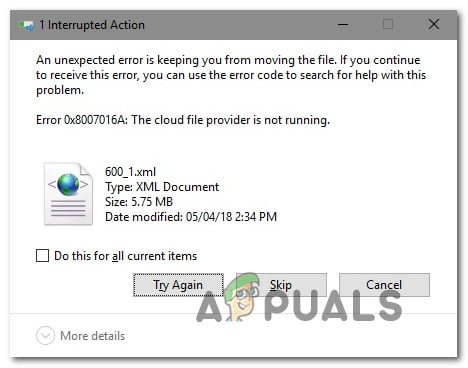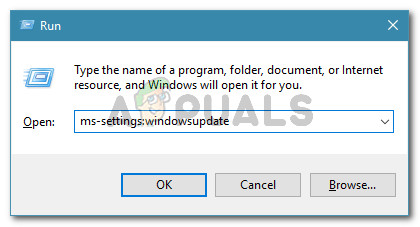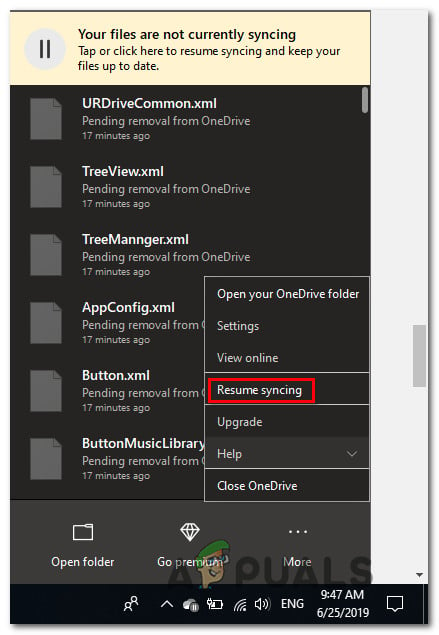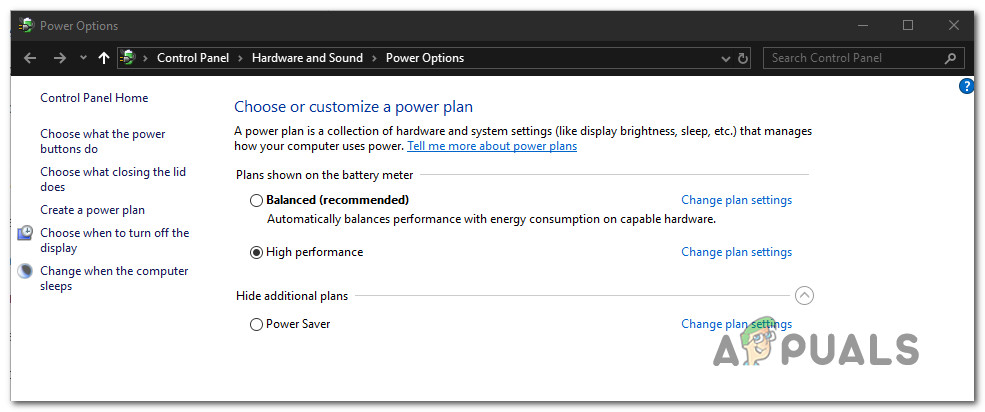What is causing the Error 0x8007016A: The Cloud File provider is not running?
We investigated this particular issue by looking at various user reports and the repair strategies that are most commonly used to fix this particular issue. As it turns out, there are several different culprits that might lead to the apparition of this issue: If you’re currently searching for a fix for the Error 0x8007016A: The Cloud File provider is not running, this article will provide you with several different troubleshooting steps. Down below, you’ll find a collection of potential fixes that other users in a similar situation have successfully used to resolve this issue and resume the normal functionality of OneDrive. To ensure that you remain as efficient as possible, we encourage you to follow the methods in the order that they are presented and ignore those potential fixes that are not applicable to your current situation. One of the methods below is bound to resolve the issue regardless of the culprit that’s causing it.
Method 1: Updating Windows 10 to the latest build (if applicable)
As it turns out, if you’re using Windows 10, chances are the issue is being caused by a bad update introduced on October 12. This update effectively ended up breaking the syncing feature of Onedrive for a lot of users. Fortunately, Microsoft was fairly quick in releasing a hotfix for the issue and made it available for everyone via WU (Windows Update). However, if you installed the bad update (KB4457128) but failed to install the hotfix for it, you might be encountering this issue as a result. If this particular case is applicable to your current situation, you should be able to resolve the issue by installing the hotfix. The simplest way to do this is to leave WU to install every pending update that is available. Here’s a quick guide on forcing WU to install every pending update on Windows 10: If you’re still encountering the Error 0x8007016A: The Cloud File provider not working with certain files or folders located in the OneDrive service, move down to the next method below.
Method 2: New Folder workaround
There is a little trick/workaround you can try in order to delete these files. Basically, you will create a new folder and delete that because when you create a new folder it’s not immediately synced with OneDrive, So it will make your files offline and you will be able to delete them, Follow these steps:-
Method 3: Disabling File-On Demand
Most affected users have reported that they managed to resolve the issue by disabling Files On-Demand from the OneDrive’s Settings menu and then deleting the semi-synced file from OneDrive. This procedure is effective in instances where a file is not fully synced – it has a thumbnail, but the file-size reads 0 KB. After doing this and restarting their computer, most affected users have reported that the Error 0x8007016A: The Cloud File provider not working no longer occurred when they tried to open or delete a file or folder located inside OneDrive. This has been a recurring bug with OneDrive for a couple of years now, and it still remains unpatched at the time of writing this. Here’s a quick guide on demanding File-On Demand from OneDrive’s Settings and deleting the semi-synced file from the shared folder: If you’re still encountering the same error message even after following the instructions above, move down to the next method below.
Method 4: Resume syncing
It’s also possible that you’re encountering this issue because of the fact that OneDrive syncing is temporarily disabled in the settings menu. This can happen as a result of manual user intervention or after a power plan or another 3rd party application has disabled the syncing process in order to conserve power. Several affected users have managed to resolve the issue by accessing OneDrive’s settings and resuming the syncing process. After doing so and restarting the service, most affected users have reported that the issue has been resolved. Here’s a quick guide on resuming OneDrive syncing on Windows 10: If the same error message is still appearing even after you’ve ensured that syncing is enabled, move down to the next method below.
Method 5: Modifying the power plan (if applicable)
As several different users have reported, this particular issue can also occur if you’re using a restrictive power plan that is actually stopping the syncing feature in order to conserve battery power. Obviously, this can only occur on laptops and other portable PCs. Several affected users have reported that they managed to resolve the issue by accessing the Power Options menu and making the switch to a power plan that doesn’t include the stoppage of file syncing. Here’s a quick guide on modifying the power plan on your Windows computer to ensure that your OS is not blocking the syncing feature of OneDrive: If the same 0x8007016A error is still occurring, move down to the next method below.
Method 6: Resetting OneDrive
Another method but one that might make you lose some user preferences is to reset the Onedrive to the factory settings. This can be done easily from a Run dialog box, but keep in mind that after doing so you will lose your saved login credentials and any other locally cached data is used to save user setting preferences. Several affected users have reported that they managed to resolve the issue by using a series of commands to reset and restart the OneDriver service. But keep in mind that this procedure will also re-sync all your OneDrive files. If you decide to go this route, here’s a quick guide on performing a OneDrive reset: If the same error is still occurring, move down to the next method below.
Method :7 Removing the glitched folder forcibly with Powershell
If you’re a tech-savvy user and none of the methods above have helped you to get rid of the 0x8007016A error, this method should allow you to forcibly remove the folder that ends up triggering the error inside the OneDrive folder. Several affected users have confirmed that this method was effective in allowing them to clean the OneDrive folder of glitched folders that we’re producing the Error 0x8007016A: The Cloud File provider everytime they tried to delete, move or rename them. Here’s a quick guide on removing a glitched folder forcibly with an elevated Powershell window: If the same Error 0x8007016A: The Cloud File provider is still occurring, move down to the final method below.
Method 8: Performing a repair install
If none of the methods above have helped you to resolve the issue, the final method should resolve every possible instance in which the error will occur as a result of a bug, glitch or system corruption. A couple of users have confirmed that performing a repair install on their Windows 10 computer has helped them to resolve the Error 0x8007016A: The Cloud File provider. This procedure will refresh all Windows components including OneDrive without touching any of your personal files (personal data, applications, games, user preferences and anything else). It’s superior to a clean install but ultimately has the same degree of efficiency when it comes to resolving corrupted files that might be causing errors of this kind. To perform a repair install on your Windows 10 computer, follow the steps on this article (here).
[FIX] Error Setting Traits on ProviderFix: Cannot Connect to WMI Provider on Windows 10Fix: WMI Provider Host (WmiPrvSE.exe) High CPU Usage On Windows 10Fix: HyperX Cloud 2 Mic not Working







